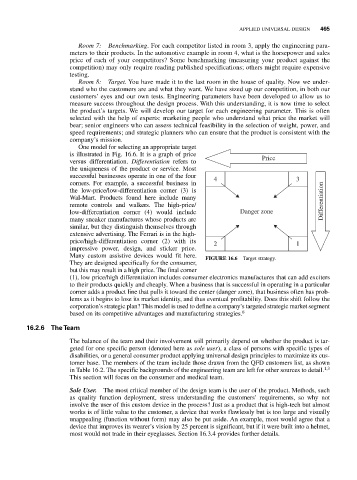Page 487 - Biomedical Engineering and Design Handbook Volume 2, Applications
P. 487
APPLIED UNIVERSAL DESIGN 465
Room 7: Benchmarking. For each competitor listed in room 3, apply the engineering para-
meters to their products. In the automotive example in room 4, what is the horsepower and sales
price of each of your competitors? Some benchmarking (measuring your product against the
competition) may only require reading published specifications; others might require expensive
testing.
Room 8: Target. You have made it to the last room in the house of quality. Now we under-
stand who the customers are and what they want. We have sized up our competition, in both our
customers’ eyes and our own tests. Engineering parameters have been developed to allow us to
measure success throughout the design process. With this understanding, it is now time to select
the product’s targets. We will develop our target for each engineering parameter. This is often
selected with the help of experts: marketing people who understand what price the market will
bear; senior engineers who can assess technical feasibility in the selection of weight, power, and
speed requirements; and strategic planners who can ensure that the product is consistent with the
company’s mission.
One model for selecting an appropriate target
is illustrated in Fig. 16.6. It is a graph of price Price
versus differentiation. Differentiation refers to
the uniqueness of the product or service. Most
successful businesses operate in one of the four 4 3
corners. For example, a successful business in
the low-price/low-differentiation corner (3) is
Wal-Mart. Products found here include many Differentiation
remote controls and walkers. The high-price/
low-differentiation corner (4) would include Danger zone
many sneaker manufactures whose products are
similar, but they distinguish themselves through
extensive advertising. The Ferrari is in the high-
price/high-differentiation corner (2) with its 2 1
impressive power, design, and sticker price.
Many custom assistive devices would fit here. FIGURE 16.6 Target strategy.
They are designed specifically for the consumer,
but this may result in a high price. The final corner
(1), low price/high differentiation includes consumer electronics manufactures that can add exciters
to their products quickly and cheaply. When a business that is successful in operating in a particular
corner adds a product line that pulls it toward the center (danger zone), that business often has prob-
lems as it begins to lose its market identity, and thus eventual profitability. Does this shift follow the
corporation’s strategic plan? This model is used to define a company’s targeted strategic market segment
based on its competitive advantages and manufacturing strategies. 6
16.2.6 The Team
The balance of the team and their involvement will primarily depend on whether the product is tar-
geted for one specific person (denoted here as sole user), a class of persons with specific types of
disabilities, or a general consumer product applying universal design principles to maximize its cus-
tomer base. The members of the team include those drawn from the QFD customers list, as shown
in Table 16.2. The specific backgrounds of the engineering team are left for other sources to detail. 1,3
This section will focus on the consumer and medical team.
Sole User. The most critical member of the design team is the user of the product. Methods, such
as quality function deployment, stress understanding the customers’ requirements, so why not
involve the user of this custom device in the process? Just as a product that is high-tech but almost
works is of little value to the customer, a device that works flawlessly but is too large and visually
unappealing (function without form) may also be put aside. An example, most would agree that a
device that improves its wearer’s vision by 25 percent is significant, but if it were built into a helmet,
most would not trade in their eyeglasses. Section 16.3.4 provides further details.

